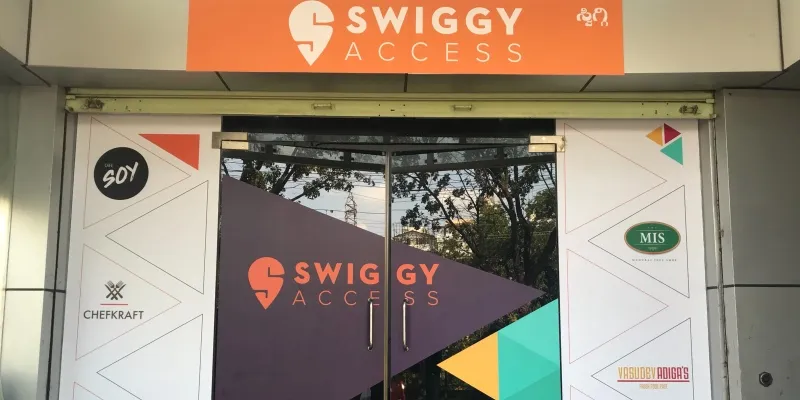Swiggy Access CEO Vishal Bhatia charts out company’s growth plan: aggressive and progressive
Debolina Biswas

Wednesday September 26, 2018 , 6 min Read
In a conversation with YourStory, Vishal Bhatia, CEO of Swiggy Access, speaks about how they are teaming up with partners and eyeing much more rapid growth than the industry has seen.
Almost a year ago, Swiggy, the newly instated unicorn in the online food delivery space, launched Swiggy Access, a central base in Marathahalli, or warehouse facility housing four restaurants.
Cut to now, and the picture’s extremely different. The Kalyan Nagar Swiggy Access centre has close to 10 kitchens. And Swiggy Access is now live in four cities - Bengaluru, Hyderabad, Kolkata, and Delhi-NCR. It will go live in Mumbai in the next couple of months.
At the launch in November last year, Sriharsha Majety, Co-founder and CEO, Swiggy, popularly known as Harsha, had informed that the idea of Swiggy Access came with an understanding of the consumers' needs and requirements.
The team had strongly felt that there was a distinct demand and supply gap in the market.
Vishal Bhatia, Swiggy Access CEO, agrees. “India just doesn’t have the number of restaurants that can complement its population size. Today, we have around 35 kitchens and 30 brands on the platform,” he says.

Eyeing aggressive growth
Vishal was appointed CEO of Swiggy New Supply a few months after Access was launched. He comes in with over 19 years of experience in blue-chip organisations like Reckitt Benckiser (RB), PepsiCo, and Britannia.
“We are now are looking at 10x the number of kitchens in the next six to nine months. And by 2020, we are looking at presence in Tier I and Tier II towns by setting up in 30 to 40 cities,” he says.
Swiggy refused to share the percentage that Access contributes to Swiggy’s deliveries. However, the team added that Access contributes eight to 25 percent in the four-km serviceable zone each centre operates.
With this expansion plan, the team is also helping partner restaurants expand into newer geographies. Citing an example, Vishal says a restaurant like Vasudev Adigas, which is Bengaluru based, will expand to Delhi for the first time with Access.
Speaking about their national expansion through Swiggy Access, Biju Thomas, COO, Vasudev Adigas, says,
“Our partnership with Swiggy Access has been a phenomenal success in Bengaluru. We’re really excited about expanding with them through Access kitchens in other cities, making our much-loved South Indian food available to new customers there. We can hit the ground running in these locations without worrying about infrastructure, overheads, and delivery costs.”
Solving the partner problem
While it common for well-funded startups to hire professional executives for CXO levels, some stick and others don’t. For Vishal, the startup world seems to hold a different charm.
“The intent of all the conversations in my joining process was consumer and consumer first; that gave me the confidence that this was an organisation trying to solve a real issue without necessarily saying that we are here to make quick money.”
The kitchens that are a part of Access work on a plug-and-play model; restaurants bring in their own equipment and need to simply start rolling out operations.
Deposits are a huge issue for restaurant partners - rentals, maintenance, housekeeping, security, and Swiggy takes care of these. The partners need to fulfil the licensing FSSAI requirements.

While Swiggy refused to share the commissions they charged restaurants, Vishal says an average high street restaurant would spend 10-15 percent on rental. In a cloud kitchen setup, they spend 2-5 percent on rental.
“The commissions are variable. We are covering our costs. Once the costs get covered, we start tapering down commissions on Access. However, there is a certain slab,” Vishal informs.
Also read: Exclusive: Welcome the new Unicorn of India
The numbers and challenges
Currently, Swiggy’s revenue per order –30 percent currently - is a blend of three parts: the commission from restaurants, delivery fee charged from consumers, and discretionary advertising revenues.
However, during the launch, Harsha had mentioned that the commissions on Access are higher than the usual marketplace model.
This is also because of the fact that restaurants do not pay rental and will get access to advertising on the Swiggy platform. The restaurant partners will also be able to leverage Swiggy’s data insights and consumer feedback.
However, the space does have challenges. One of the big ones is that Swiggy wants to expand much more aggressively than the industry has seen expansion.
“It is going to be a learning point for us and our partners. We are keeping the larger brands - Adigas, Paradise, Truffles. These are big names; this takes care of the quality,” Vishal says.
Progressive growth
For example, Truffles has eight restaurants in Bengaluru. Two of them are on Swiggy Access, so 25 percent of their restaurants are on Swiggy Access. As operational costs are much lesser, it lets them expand more freely.
“We are progressively solving our partner's problems - location was one of them, then there is licensing. We assist our partners get the requirements. We work with data, assist our partners, and enable them to grow. Packaging is something we have worked on. The one thing that I understand is that this industry was not built for delivery - it was built for families coming together and having a meal together. We are changing that paradigm,” Vishal says.
It has been the year of foodtech. When Swiggy started operations in August 2014, its main proposition was to ensure it delivered food not only from high-end restaurants, but also pocket-friendly joints, and everything in between.
But this year, Swiggy has seen different growth curves. In March, it raised $100 million from Naspers, while Zomato raised $200 million from Ant Financials in February. Earlier Swiggy raised another $210 million led by DST Global and touched unicorn status.
“With both Swiggy and Zomato joining the billion-dollar club, both will want to conquer the market as fast as they can. Swiggy currently is looking to conquer the market quicker than ever before, and that is why it has been acquiring companies, looking at different market segments to break into, and building a healthy business model,” says an investor on condition of anonymity.
What lies ahead?
To fuel its ambitions to conquer the market, Swiggy has kept busy this year. It has raised big monies, launched Swiggy Access and Swiggy POP, its quick meal delivery service opened up in newer geographies, and even acquired Bengaluru-based cloud restaurant 48East. It also acquired Mumbai-based Scootsy, and launched new packaging solutions.
With Access, Swiggy aims to reach deeper into the market. Is it looking at acquisitions? Vishal says not immediately, but they are open to idea. And what if rival Zomato enters a similar fray?
“We started this journey nine months ago, and at the end of the day, our focus is to provide quality food to consumers. If there is another company trying to do the same, I would welcome them. Let us provide consumers the food they deserve,” says a confident Vishal.







![[Weekly funding roundup] Investments into startups decline by 57 pc, closes at $107 million](https://images.yourstory.com/cs/2/f08163002d6c11e9aa979329348d4c3e/Weeklyimage-1577460362436.png)


![[Exclusive] Vauld to seek 3-month moratorium extension as creditors panel explores bailout options](https://images.yourstory.com/cs/2/a09f22505c6411ea9c48a10bad99c62f/VauldStoryCover-01-1667408888809.jpg)